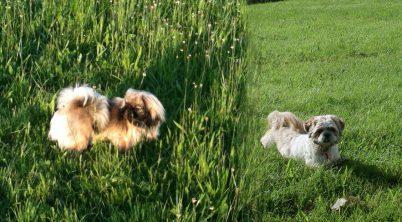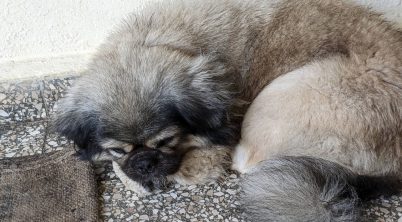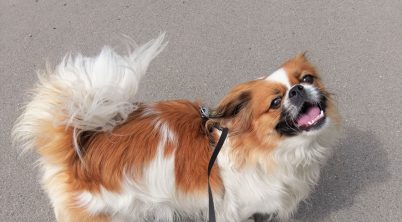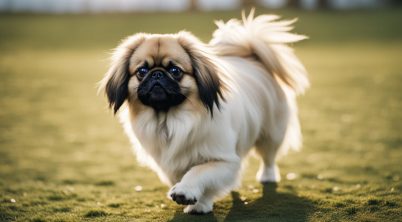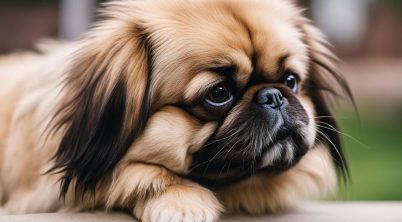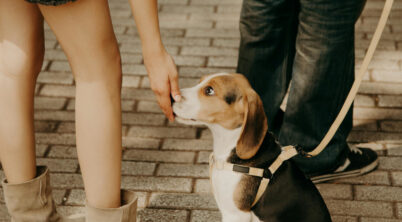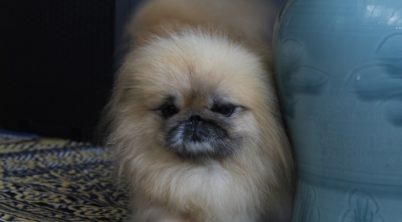The Pekingese, often referred to as the Lion Dog, is a toy breed steeped in rich history stemming from ancient China. Regarded as a canine symbol of regal dignity, this breed was once the exclusive companion of the Chinese imperial family. With its distinctive flat face, lush mane, and compact, sturdy body, the Pekingese bears an intentional resemblance to the mythical Chinese guardian lions, embodying both an air of nobility and a fierce spirit.
Originating from the imperial courts of China, the Pekingese’s legacy as a favored pet among royalty cements its cultural significance. Their association with Chinese Buddhism further underscores their revered status, as monks would also keep these dogs. This historical bond between the Pekingese and the affluent classes of China encapsulates a unique aspect of the breed’s identity, distinguishing it as a living relic of a bygone era.
Despite its toy classification, the Pekingese is known for a bold and courageous disposition, traits highly valued by those who kept them in the Forbidden City. These dogs were not only treasured for their striking appearance but also for their spirited personalities. Today, although they are no longer confined to the laps of emperors, the Pekingese continues to be celebrated for its ancient lineage and character, which preserves the essence of its imperial past.
Table of Contents
What is Pekingese Lion
The Pekingese Lion, commonly known as the Pekingese, is a toy dog breed originating from China. Characterized by a lion-like mane and a compact, muscular body, this breed exudes a regal presence. Traditionally, the Pekingese were exclusive companions of Chinese royalty, which is why they are often referred to as “lion dogs.”
Physical Attributes:
- Size: Small, typically no more than 14 pounds in weight.
- Coat: Long, flowing with a thick undercoat.
- Color: Variety of colors, including gold, red, and sable.
Historical Significance:
- Origin: China, particularly associated with the city of Beijing.
- Status: Once held as sacred by the nobility in Ancient China.
Temperament:
- Behavior: Confident and independent.
- Character: They possess a courageous spirit despite their small size.
Health Considerations:
- Several health issues are related to their distinct physical build, such as breathing difficulties and eye conditions.
Due to their deep historical roots and status as a symbol of royalty, the Pekingese holds a special place in Chinese culture and is admired for its dignified and steadfast character. Their role as companion animals to Buddhist monks and Chinese emperors reflects their longstanding integration into the fabric of Chinese society.
History and Origin of the Pekingese
The Pekingese, often symbolized as a miniature lion, boasts an illustrious lineage rooted in Ancient China. Originating during the Tang Dynasty, this breed exemplified luxury and status within the Chinese Imperial Court. They were so revered that ownership was restricted exclusively to members of the imperial family, encapsulating their unique position in Chinese society.
Historically, the breed’s patronage came to peaks during the reign of the Dowager Empress Cixi of the Han Dynasty, when the Pekingese received unparalleled favor. Their sacred status linked them closely to Chinese lore, elevating the Pekingese to a celestial symbol interwoven with the fabric of spiritual and royal life.
The breed’s introduction to the Western world was marked by the Second Opium War when British troops entered the Forbidden City in 1860. A turning point came with the discovery of five Pekingese dogs guarding the body of an aunt to the emperor, who had sadly perished. One of these dogs, named Looty, was taken and later presented to Queen Victoria, marking the breed’s entry into Europe and sparking international interest.
Characteristics of the Pekingese include:
- Distinctive lion-like appearance
- Rolling gait
- Regal demeanor
Through its venerable history, the Pekingese continues to be a testament to the rich tapestry of Chinese cultural heritage.
Physical Characteristics
The Pekingese boasts a lion-like appearance marked by a unique blend of dignity and compactness. They carry themselves confidently, sure to draw the eye with their regal bearing and distinctive physical traits.
Size and Appearance
The Pekingese is known for its small yet sturdy stature. They typically stand 6 to 9 inches at the shoulder and a healthy Pekingese weighs in the range of 7 to 14 pounds. This toy breed exemplifies a “big dog in a little body,” with a well-proportioned, muscular build that exudes confidence. Their physical appearance includes large eyes and a flat face with a characteristically short snout.
Coat and Color Variations
Their most striking feature is arguably the coat, which is lush and double-layered. The outer coat is long and coarse, while the undercoat remains soft and dense. The Pekingese has a broad palette of colors, including but not limited to black, fawn, sable, cream, red, white, gold, and black and tan. Regular grooming is essential to maintain the coat’s fullness and prevent matting, particularly around their “lion-like” mane which is a hallmark of the breed.
The Pekingese Temperament
The Pekingese breed exhibits a complex temperament that intertwines affection, independence, and loyalty. These dogs are known for their regal and dignified nature that reflects their imperial Chinese heritage.
Behavioral Traits
- Affectionate: Pekingese are known for their deep bond with their family, often showing a warm and affectionate side to those they trust.
- Independent: They possess a strong sense of independence which can sometimes be mistaken for stubbornness.
- Stubborn: This independence often translates to a stubborn streak, especially when it comes to training.
- Intelligent: Pekingese are intelligent canines, capable of understanding and responding to various commands and situations.
- Loyal: Their loyalty to their owners is unwavering, frequently leading them to be protective.
- Aloof: With strangers, a Pekingese can be aloof, displaying indifference towards those they are not familiar with.
- Protective: This breed can exhibit protective behaviors, particularly within the home environment.
- Good-Natured: Despite some of these traits, Pekingese generally have a good-natured attitude and can be very pleasant companions.
Interaction with Family and Pets
- Children: They can be loving with children, but their tolerance may wane with rough play. Close supervision is recommended.
- Other Pets: Pekingese may coexist peacefully with other pets if they are properly introduced and socialized from a young age; however, their independent streak can sometimes lead to aggression if not managed correctly.
Health and Lifespan
The Pekingese breed typically enjoys a lifespan of about 12 to 15 years. To ensure a full and healthy life, regular exercise is recommended, though it should be moderate due to their compact build. As with any breed, maintaining an optimal weight is crucial, and owners should be vigilant to prevent their Pekingese from becoming overweight, which can lead to additional health problems.
One of the common health concerns in Pekingese is breathing difficulties, exacerbated by their short muzzle. Known as brachycephalic syndrome, this condition can affect the dog’s ability to exercise and stay cool in warm weather. Owners are advised to monitor their pets closely for signs of labored breathing or overheating.
Eye issues are also prevalent in this breed due to their large, prominent eyes. They are at risk for conditions like ulcers and scratches. Consistent check-ups with a veterinarian are necessary to catch and treat any eye problems early.
| Component | Considerations |
|---|---|
| Exercise | Moderate; avoid overexertion |
| Weight Management | Prevent obesity for health |
| Breathing | Monitor for difficulties; keep cool |
| Eye Health | Regular veterinary checks for early detection |
Responsible ownership, including adequate healthcare and the maintenance of a comfortable environment, plays a significant role in managing the health and extending the life of a Pekingese. Owners can increase their furry friend’s longevity by attentively addressing the breed’s unique health needs.
Grooming and Care
Grooming a Pekingese is a vital part of their care, focusing on maintaining their distinctive double coat. This breed’s coat consists of a thick undercoat and a longer outer coat that needs regular brushing to prevent matting and to manage shedding.
Weekly Brushing Routine
- Daily: Brush the coat to remove dirt and loose fur, using a bristle brush.
- 2-3 times a week: Work on deeper knots and tangles with a long-toothed comb.
Bathing
Bathing a Pekingese should be done every few months or as necessary. Owners should use a dog-appropriate shampoo to protect the natural oils in their coat.
Specific Cuts
The Lion Cut is popular among Pekingese owners. This involves:
- Keeping the hair on the face, ears, and neck long.
- Trimming the body hair short, except for the ‘mane,’ tail, and hindquarters.
Health Considerations
Consistent grooming leads to better health, as it allows owners to check for skin issues, parasites, and to keep the dog’s eyes clear from obstructed vision.
Exercise and Activity
While grooming is essential, a Pekingese also requires regular exercise to stay healthy. Moderate activity, such as short walks or play sessions, is enough to meet their needs, balancing their physical health with their grooming requirements.
Regular grooming and sufficient exercise are non-negotiable aspects of Pekingese care. They not only keep the dog looking presentable but also contribute significantly to their overall well-being.
The Pekingese in Culture
The Pekingese dog has long been a symbol of cultural significance in China, embodied by its associations with ancient royalty, Buddhist iconography, and its pervasive presence in historical texts.
Symbolism and Significance
Chinese Emperor’s Companions: Historically, the Pekingese breed has been the epitome of regal elegance and status. They were the exclusive property of the Chinese Imperial family, where emperors, as well as members of the royal household, prized them as lapdogs and companions. The association with Chinese emperors lent the Pekingese an aura of divinity and reverence.
Buddhist Connections: According to cultural lore, the Pekingese is believed to have ties with Buddhism. The breed’s lion-like appearance is said to reflect Buddhist stories in which the lion is a sacred creature, serving as a symbol for Buddha. This connection established the Pekingese not only as regal figures but also as spiritual protectors.
Imperial Significance: Within the strict hierarchies of the imperial court, Pekingese were often referred to as “sleeve dogs,” as they could be carried in the voluminous sleeves of the Imperial family members. The Dowager Empress, for instance, was known for her affection towards these dogs, further bolstering their status as dogs of nobility.
Cultural Treasures Beyond the Forbidden City: The breed’s international prominence expanded in the 19th century when Pekingese were introduced to the West. Notably, Queen Victoria received a Pekingese dog, exemplifying its appeal as a charming and dignified companion beyond its native land.
Color Symbolism: The color red holds special significance in Chinese culture, symbolizing good fortune and joy. Red Pekingese were, and still are, highly cherished for their auspicious hue, tying them closely with cultural celebrations and Chinese mythology.
In essence, the Pekingese is a breed deeply woven into the cultural fabric of China. From its roots in Buddhism to its illustrious place in the courts of Chinese emperors, the Pekingese has maintained its status as a symbol of cultural pride and historical significance.
* Banner photo by Kristin “Shoe” Shoemaker, cropped | Some rights reserved

